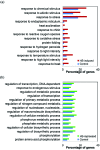Genome-wide Analysis of Alternative Splicing in An Inbred Cabbage (Brassica oleracea L.) Line 'HO' in Response to Heat Stress
- PMID: 29491729
- PMCID: PMC5817872
- DOI: 10.2174/1389202918666170705151901
Genome-wide Analysis of Alternative Splicing in An Inbred Cabbage (Brassica oleracea L.) Line 'HO' in Response to Heat Stress
Abstract
Introduction: High-throughput RNA sequencing (RNA-Seq) studies demonstrate that Alter-native Splicing (AS) is a widespread mechanism that enhances transcriptome diversity, particularly in plants exposed to environmental stress. In an attempt to determine the transcriptome and AS patterns of cabbage inbred line "HO" under Heat Stress (HS), RNA-Seq was carried out using HS-treated and con-trol samples. Genome-wide analysis indicated that AS is differentially regulated in response to HS. The number of AS events markedly increased in HS-treated samples compared to the control.
Conclusion: We identified 1,864 genes, including Heat shock transcription factor (Hsf) and heat shock protein (Hsp) genes, that exhibited >4-fold changes in expression upon exposure to HS. The enriched Gene Ontology (GO) terms of the 1,864 genes included 'response to stress/abiotic stimulus/chemical stimulus', among, which the genes most highly induced by HS encode small Hsps and Hsf proteins. The heat-induced genes also showed an increased number of AS events under HS conditions. In addi-tion, the distribution of AS types was altered under HS conditions, as the level of Intron Retention (IR) decreased, whereas other types of AS increased, under these conditions. Severe HS-induced AS was al-so observed in Hsfs and Hsps, which play crucial roles in regulating heat tolerance. Our results support the notion that AS of HS-related genes, such as HsfA2 and HsfB2a, are important for heat stress adapta-tion in cabbage.
Keywords: Alternative splicing; Cabbage; Heat shock; Heat shock protein; Heat shock transcription factor; Transcriptome.
Figures







References
-
- Hedhly A., Hormaza J.I., Herrero M. Global warming and sexual plant reproduction. Trends Plant Sci. 2009;14:30–36. - PubMed
-
- Lobell D.B., Field C.B. Global scale climate-crop yield relationships and the impacts of recent warming. Environ. Res. Lett. 2007;2:1–7.
-
- Lobell D.B., Schlenker W., Costa-Roberts J. Climate trends and global crop production since 1980. Science. 2011;333:616–620. - PubMed
-
- Scharf K.D., Berberich T., Ebersberger I., Nover L. The plant heat stress transcription factor (Hsf) family, structure, function and evolution. Biochim. Biophys. Acta. 2012;1819:104–119. - PubMed
LinkOut - more resources
Full Text Sources
Other Literature Sources
Molecular Biology Databases
Research Materials
